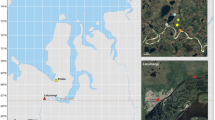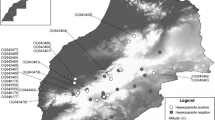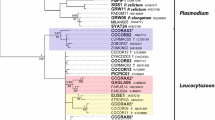Abstract
We studied haemosporidian parasites in the scarlet rosefinch Carpodacus erythrinus in a small isolated semicolony during an eight-year period using molecular methods of parasite detection. The scarlet rosefinch is an interesting model of parasite host species. It winters in South Asia which represents a rare exception among European passerines. Males express yellow to red carotenoid-based plumage ornament which is a good predictor of male reproductive success. In 240 blood samples originating from 199 adult individuals, the total parasite prevalence reached 60 %. Prevalence varied among years from 36 to 81 % in Haemoproteus, 8 to 22 % in Plasmodium, and 0 to 14 % in Leucocytozoon. Twenty parasite lineages were detected (Haemoproteus: 5 lineages, Plasmodium: 10 lineages, and Leucocytozoon: 5 lineages). Among them, the Haemoproteus ROFI2 lineage, which is a host-specific parasite lineage of the scarlet rosefinch, was the most frequently found. Parasite lineages showed varying degree of lineage specificity. While Haemoproteus lineages detected in the scarlet rosefinch have relatively narrow host breadth restricted mainly to Fringillidae family, Leucocytozoon and Plasmodium lineages generally showed wider host range. The presence of some parasite lineages hitherto detected in sedentary European passerines (SISKIN1, CCF3, BT2) or in Culicoides biting midges at the same locality (ROFI1) suggest local transmission. On the contrary, lineages LK05 and FANTAIL1 that were previously reported exclusively from Asian hosts imply parasite transmission at the scarlet rosefinch wintering sites in South Asia. Mixed infections were found in 17 % of infected samples and comprised mainly the most frequent lineages. The pattern of concomitant infections seemed to be rather random and matched expected levels based on lineage frequencies. Between-year comparisons revealed that in a majority of the repeatedly captured individual hosts the infection status remained unchanged (individuals stayed uninfected or possessed the same parasite lineages). However, 16 gains and 8 losses of lineages were also reported. We have not found any effect of haemosporidians on male carotenoid ornament expression or host body mass.

Similar content being viewed by others
References
Albrecht T (2004) Edge effect in wetland-arable land boundary determines nesting success of scarlet rosefinches (Carpodacus erythrinus) in the Czech Republic. Auk 121:361–371
Albrecht T, Schnitzer J, Kreisinger J, Exnerová A, Bryja J, Munclinger P (2007) Extrapair paternity and the opportunity for sexual selection in long-distant migratory passerines. Behav Ecol 18:477–486
Albrecht T, Vinkler M, Schnitzer J, Poláková R, Munclinger P, Bryja J (2009) Extra-pair fertilizations contribute to selection on secondary male ornamentation in a socially monogamous passerine. J Evol Biol 22:2020–2030
Asghar M, Hasselquist D, Bensch S (2011) Are chronic avian haemosporidian infections costly in wild birds? J Avian Biol 42:530–537
Badyaev AV, Hill GE (2000) Evolution of sexual dichromatism: contribution of carotenoid- versus melanin-based coloration. Biol J Linn Soc 69:153–172
Beadell JS, Covas R, Gebhard C, Ishtiaq F, Melo M, Schmidt BK, Perkins SL, Graves GR, Fleischer RC (2009) Host associations and evolutionary relationships of avian blood parasites from West Africa. Int J Parasitol 39:257–266
Beadell JS, Ishtiaq F, Covas R, Melo M, Warren BH, Atkinson CT, Bensch S, Graves GR, Jhala YV, Peirce MA, Rahmani AR, Fonseca DM, Fleischer RC (2006) Global phylogeographic limits of Hawaii's avian malaria. P Roy Soc Lond B Bio 273:2935–2944
Bensch S, Hellgren O, Pérez-Tris (2009) MalAvi: a public database of malaria parasites and related haemosporidians in avian hosts based on mitochondrial cytochrome b lineages. Mol Ecol Resour 9:1353–1358
Bensch S, Pérez-Tris J, Waldenström J, Hellgren O (2004) Linkage between nuclear and mitochondrial DNA sequences in avian malaria parasites: Multiple cases of cryptic speciation? Evolution 58:1617–1621
Bensch S, Stjernman M, Hasselquist D, Ostman O, Hansson B, Westerdahl H, Pinheiro RT (2000) Host specificity in avian blood parasites: a study of Plasmodium and Haemoproteus mitochondrial DNA amplified from birds. P Roy Soc Lond B Bio 267:1583–1589
Bensch S, Waldenström J, Jonzen N, Westerdahl H, Hansson B, Sejberg D, Hasselquist D (2007) Temporal dynamics and diversity of avian malaria parasites in a single host species. J Anim Ecol 76:112–122
Bennett GF, Peirce MA, Ashford RW (1993) Avian Haematozoa—mortality and pathogenicity. J Nat Hist 27:993–1001
Bentz S, Rigaud T, Barroca M, Martin-Laurent F, Bru D, Moreau J, Faivre B (2006) Sensitive measure of prevalence and parasitaemia of haemosporidia from European blackbird (Turdus merula) populations: value of PCR-RFLP and quantitative PCR. Parasitology 133:685–692
Cramp P, Perrins CM, Brooks DJ (1994) The birds of Western Paleartic. Oxford University Press, Oxford
Crawley MJ (2007) The R book. Wiley, Chichester
Dale S, Kruszewicz A, Slagsvold T (1996) Effects of blood parasites on sexual and natural selection in the pied flycatcher. J Zool 238:373–393
Deviche P, McGraw K, Greiner EC (2005) Interspecific differences in hematozoan infection in sonoran desert Aimophila sparrows. J Wildlife Dis 41:532–541
Ferrer ES, Garcia-Navas V, Sanz JJ, Ortego J (2012) Molecular characterization of avian malaria parasites in three Mediterranean blue tit (Cyanistes caeruleus) populations. Parasitol Res 111:2137–2142
Fallon SM, Ricklefs RE, Swanson BL, Bermingham E (2003) Detecting avian malaria: an improved polymerase chain reaction diagnostic. J Parasitol 89:1044–1047
Gibb CE, Jones J, Girvan MK, Barg JJ, Robertson RJ (2005) Geographic variation in prevalence and parasitemia of Haemoproteus paruli in the cerulean warbler (Dendroica cerulea). Can J Zoll 83:626–629
Gonzalez G, Sorci G, Møller AP, Ninni P, Haussy C, De Lope F (1999) Immunocompetence and condition-dependent sexual advertisement in male house sparrows (Passer domesticus). J Anim Ecol 68:1225–1234
Hasselquist D, Östman Ö, Waldenström J, Bensch S (2007) Temporal patterns of occurrence and transmission of the blood parasite Haemoproteus payevskyi in the great reed warbler Acrocephalus arundinaceus. J Ornithol 148:401–409
Hellgren O, Pérez-Tris J, Bensch S (2009) A jack-of-all-trades and still a master of some: prevalence and host range in avian malaria and related blood parasites. Ecology 90:2840–2849
Hellgren O, Waldenström J, Bensch S (2004) A new PCR assay for simultaneous studies of Leucocytozoon, Plasmodium, and Haemoproteus from avian blood. J Parasitol 90:797–802
Hellgren O, Waldenström J, Pérez-Tris J, Szollosi E, Hasselquist D, Križanauskienė A, Ottosson U, Bensch S (2007) Detecting shifts of transmission areas in avian blood parasites—a phylogenetic approach. Mol Ecol 16:1281–1290
Hõrak P, Ots I, Vellau H, Spottiswoode C, Møller AP (2001) Carotenoid-based plumage coloration reflects hemoparasite infection and local survival in breeding great tits. Oecologia 126:166–173
Kilpatrick AM, LaPointe DA, Atkinson CT, Woodworth BL, Lease JK, Reiter ME, Gross K (2006) Effects of chronic avian malaria (Plasmodium relictum) infection on reproductive success of Hawaii Amakihi (Hemignathus virens). Auk 123:764–774
Kimura M, Dhondt AA, Lovette IJ (2006) Phylogeographic structuring of Plasmodium lineages across the North American range of the house finch (Carpodacus mexicanus). J Parasitol 92:1043–1049
Knowles SCL, Palinauskas V, Sheldon BC (2010) Chronic malaria infections increase family inequalities and reduce parental fitness: experimental evidence from a wild bird population. J Evol Biol 23:557–569
Knowles SCL, Wood MJ, Alves R, Wilkin TA, Bensch S, Sheldon BC (2011) Molecular epidemiology of malaria prevalence and parasitaemia in a wild bird population. Mol Ecol 20:1062–1076
Križanauskienė A, Hellgren O, Kosatec V, Sokolov L, Bensch S, Valkinūas G (2006) Variation in host specificity between species of avian haemosporidian parasites: evidence from parasite morphology and cytochrome b gene sequences. J Parasitol 92:1319–1324
Loiseau C, Zoorob R, Garnier S, Birard J, Federici P, Julliard R, Sorci G (2008) Antagonistic effects of a Mhc class I allele on malaria-infected house sparrows. Ecol Lett 11:258–265
Lozano GA (1994) Carotenoids, parasites, and sexual selection. Oikos 70:309–311
Marzal A, de Lope F, Navarro C, Møller AP (2005) Malarial parasites decrease reproductive success: an experimental study in a passerine bird. Oecologia 142:541–554
Marzal A, Bensch S, Reviriego M, Balbontin J, de Lope F (2008) Effects of malaria double infection in birds: one plus one is not two. J Evol Biol 21:979–987
Marzal A, Ricklefs RE, Valkiūnas G, Albayrak T, Arriero E, Bonneaud C, Czirják GA, Ewen J, Hellgren O, Hořáková D, Iezhova TA, Jensen H, Križanauskienė A, Lima MR, de Lope F, Magnussen E, Martin LB, Møller AP, Palinauskas V, Pap PL, Pérez-Tris J, Sehgal RN, Soler M, Szöllosi E, Westerdahl H, Zetindjiev P, Bensch S (2011) Diversity, loss, and gain of malaria parasites in a globally invasive bird. PLoS One 6:e21905
Merila J, Sheldon BC (1999) Testis size variation in the greenfinch Carduelis chloris: relevance for some recent models of sexual selection. Behav Ecol Sociobiol 45:115–123
Merino S, Moreno J, Sanz JJ, Arriero E (2000) Are avian blood parasites pathogenic in the wild? A medication experiment in blue tits (Parus caeruleus). P Roy Soc Lond B Bio 267:2507–2510
Merino S, Moreno J, Vásquez RA, Martínez J, Sánchez-Monsálvez I, Estades CF, Ippi S, Sabat P, Rozzi R, McGehee S (2008) Haematozoa in forest birds from southern Chile: latitudinal gradients in prevalence and parasite lineage richness. Austral Ecol 33:329–340
Ortego J, Calabuig G, Cordero PJ, Aparicio JM (2008) Genetic characterization of avian malaria (Protozoa) in the endangered lesser kestrel, Falco naumanni. Parasitol Res 101:1153–1156
Outlaw DC, Ricklefs RE (2009) On the phylogenetic relationships of haemosporidian parasites from raptorial birds (Falconiformes and Strigiformes). J Parasitol 95:1171–1176
Palinauskas V, Valkiūnas GN, Bolshakov CV, Bensch S (2008) Plasmodium relictum (lineage P-SGS1): effects on experimentally infected passerine birds. Exp Parasitol 120:372–380
Palinauskas V, Valkiūnas G, Bolshakov CV, Bensch S (2011) Plasmodium relictum (lineage SGS1) and Plasmodium ashfordi (lineage GRW2): The effects of the co-infection on experimentally infected passerine birds. Exp Parasitol 127:527–533
Pavlova A, Zink RM, Rohwer S (2005) Evolutionary history population genetics and gene flow in the common rosefinch (Carpodacus erythrinus). Mol Phylogenet Evol 36:669–681
Pérez-Tris J, Hellgren O, Križanauskienė A, Waldenstrom J, Secondi J, Bonneaud C, Fjeldsa J, Hasselquist D, Bensch S (2007) Within-host speciation of malaria parasites. PlosOne 2:e235
Reullier J, Perez-Tris J, Bensch S, Secondi J (2006) Diversity, distribution and exchange of blood parasites meeting at an avian moving contact zone. Mol Ecol 15:753–763
Richard FA, Sehgal RNM, Jones HI, Smith TB (2002) A comparative analysis of PCR-based detection methods for avian malaria. J Parasitol 88:819–822
Ricklefs RE, Fallon SM (2002) Diversification and host switching in avian malaria parasites. Proc R Soc Lond B 269:885–892
Sanz JJ, Moreno J, Arriero E, Merino S (2002) Reproductive effort and blood parasites of breeding pied flycatchers: the need to control for interannual variation and initial health state. Oikos 96:299–306
Seutin G (1994) Plumage redness in Redpoll Finches does not reflect hemoparasitic infection. Oikos 70:280–286
Smith RB, Greiner EC, Wolf BO (2004) Migratory movements of Sharp-shinned hawks (Accipiter striatus) captured in New Mexico in relation to prevalence intensity and biogeography of avian hematozoa. Auk 121:837–846
Stjernberg T (1979) Breeding biology and population dynamics of the scarlet rosefinch Carpodacus erythrinus. Finnish Zoological Pub, Board
Sundberg J (1995) Parasites, plumage coloration and reproductive success in the yellowhammer. Emberiza citrinella OIKOS 74:331–339
Synek P, Munclinger P, Albrecht T, Votypka J (2013) Avian haemosporidians in haematophagous insects in the Czech Republic. Parasitol Res 112:839–845
Valkiūnas G (2005) Avian malaria parasites and other haemosporidia. CRC, Boca Raton
Valkiūnas G (2011) Haemosporidian vector research: marriage of molecular and microscopical approaches is essential. Mol Ecol 20:3084–3086
Valkiūnas G, Zickus T, Shapoval AP, Lezhova TA (2006) Effect of Haemoproteus belopolskyi (Haemosporida: Haemoproteidae) on body mass of the blackcap Sylvia atricapilla. J Parasitol 92:1123–1125
Valkiūnas G, Iezhova TA, Loiseau C, Chasar A, Smith TB, Sehgal RNM (2008a) New species of haemosporidian parasites (Haemosporida) from African rainforest birds, with remarks on their classification. Parasitol Res 103:1213–1228
Valkiūnas G, Zehtindjiev P, Dimitrov D, Križanauskiene A, Iezhova TA, Bensch S (2008b) Polymerase chain reaction-based identification of Plasmodium (Huffia) elongatum, with remarks on species identity of haemosporidian lineages deposited in GenBank. Parasitol Res 102:1185–1193
Valkiūnas G, Iezhova TA, Loiseau C, Sehgal RNM (2009a) Nested cytochrome B polymerase chain reaction diagnostics detect sporozoites of hemosporidian parasites in peripheral blood of naturally infected birds. J Parasitol 95:1512–1515
Valkiūnas G, Iezhova TA, Loiseau C, Smith TB, Sehgal RNM (2009b) New malaria parasites of the subgenus Novyella in African rainforest birds, with remarks on their high prevalence, classification and diagnostics. Parasitol Res 104:1061–1077
Vinkler M, Albrecht T (2010) Carotenoid maintenance handicap and the physiology of carotenoid-based signalisation of health. Naturwissenschaften 97:19–28
Vinkler M, Schnitzer J, Munclinger P, Albrecht T (2012) Phytohaemagglutinin skin-swelling test in scarlet rosefinch males: low-quality birds respond more strongly. Anim Behav 83:17–23
Vinkler M, Schnitzer J, Munclinger P, Votýpka J, Albrecht T (2010) Haematological health assessment in a passerine with extremely high proportion of basophils in peripheral blood. J Ornithol 151:841–849
Votýpka J, Simek J, Tryjanowski P (2003) Blood parasites, reproduction and sexual selection in the red-backed shrike (Lanius collurio). Ann Zool Fenn 40:431–439
Waldenström J, Bensch S, Kiboi S, Hasselquist D, Ottosson U (2002) Cross-species infection of blood parasites between resident and migratory songbirds in Africa. Mol Ecol 11:1545–1554
Westerdahl H (2007) Passerine MHC: genetic variation and disease resistance in the wild. J Ornithol 148:S469–S477
Westerdahl H, Waldenström J, Hansson B, Hasselquist D, von Schantz T, Bensch S (2005) Associations between malaria and MHC genes in a migratory songbird. P Roy Soc Lond B Bio 272:1511–1518
Wood MJ, Cosgrove CL, Wilkin TA, Knowles SCL, Day KP, Sheldon BC (2007) Within population variation in prevalence and lineage distribution of avian malaria in blue tits, Cyanistes caeruleus. Mol Ecol 16:3263–3273
Yohannes E, Križanauskienė A, Valcu M, Bensch S, Kempenaers B (2009) Prevalence of malaria and related haemosporidian parasites in two shorebird species with different winter habitat distribution. J Ornithol 150:287–291
Zehtindjiev P, Ilieva M, Westerdahl H, Hansson B, Valkiūnas G, Bensch S (2008) Dynamics of parasitemia of malaria parasites in a naturally and experimentally infected migratory songbird, the great reed warbler Acrocephalus arundinaceus. Exp Parasitol 119:99–110
Zehtindjiev P, Ilieva M, Križanauskiene A, Oparina O, Oparin M, Staffan Bensch S (2009) Occurrence of haemosporidian parasites in the paddyfield warbler, Acrocephalus agricola (Passeriformes, Sylviidae). Acta Parasitol 54:295–300
Zehtindjiev P, Križanauskienė A, Bensch S, Palinauskas V, Asghar M, Dimitrov D, Scebba S, Valkiūnas G (2012) A new morphologically distinct avian malaria parasite that fails detection by established polymerase chain reaction-based protocols for amplification of the cytochrome B gene. J Parasitol 98:657–665
Acknowledgments
The study was supported by Czech Science Foundation (GA ČR) grant No. P506/10/0716. P. Synek received support from the SVV 2013-267 201 project of the Charles University in Prague. We acknowledge the help of our colleagues and friends Jaroslav Jelínek and František Zicha in the field and thank Zdena Csiebreiová for her technical assistance in the laboratory.
Ethical standards
This study was performed under certificate of competency according to §17 of the Act No. 246/1992 coll. on Protection Animals against Cruelty and comply with the current law of the Czech Republic.
Conflict of interest
The authors declare that they have no conflict of interest.
Author information
Authors and Affiliations
Corresponding author
Appendices
Appendix 1
Appendix 2
Rights and permissions
About this article
Cite this article
Synek, P., Albrecht, T., Vinkler, M. et al. Haemosporidian parasites of a European passerine wintering in South Asia: diversity, mixed infections and effect on host condition. Parasitol Res 112, 1667–1677 (2013). https://doi.org/10.1007/s00436-013-3323-5
Received:
Accepted:
Published:
Issue Date:
DOI: https://doi.org/10.1007/s00436-013-3323-5




